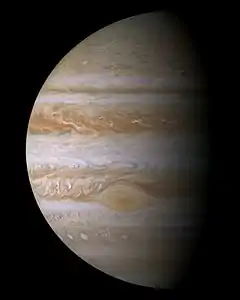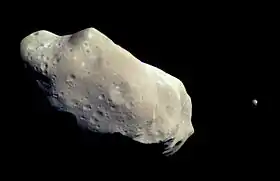Moons of Jupiter
There are 79 known moons of Jupiter, not counting a number of moonlets likely shed from the inner moons.[1][2] The most massive of the moons are the four Galilean moons, which were independently discovered in 1610 by Galileo Galilei and Simon Marius and were the first objects found to orbit a body that was neither Earth nor the Sun. Much more recently, beginning in 1892, dozens of far smaller Jovian moons have been detected and have received the names of lovers or daughters of the Roman god Jupiter or his Greek equivalent Zeus. The Galilean moons are by far the largest and most massive objects to orbit Jupiter, with the remaining 75 known moons and the rings together composing just 0.003% of the total orbiting mass.
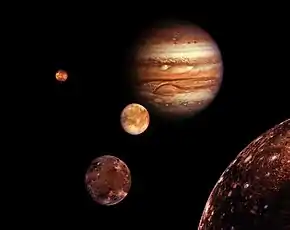
Of Jupiter's moons, eight are regular satellites with prograde and nearly circular orbits that are not greatly inclined with respect to Jupiter's equatorial plane. The Galilean satellites are nearly spherical in shape due to their planetary mass, and so would be considered at least dwarf planets if they were in direct orbit around the Sun. The other four regular satellites are much smaller and closer to Jupiter; these serve as sources of the dust that makes up Jupiter's rings. The remainder of Jupiter's moons are irregular satellites whose prograde and retrograde orbits are much farther from Jupiter and have high inclinations and eccentricities. These moons were probably captured by Jupiter from solar orbits. Twenty-two of the irregular satellites have not yet been officially named.
Characteristics
The physical and orbital characteristics of the moons vary widely. The four Galileans are all over 3,100 kilometres (1,900 mi) in diameter; the largest Galilean, Ganymede, is the ninth largest object in the Solar System, after the Sun and seven of the planets, Ganymede being larger than Mercury. All other Jovian moons are less than 250 kilometres (160 mi) in diameter, with most barely exceeding 5 kilometres (3.1 mi).[note 1] Their orbital shapes range from nearly perfectly circular to highly eccentric and inclined, and many revolve in the direction opposite to Jupiter's rotation (retrograde motion). Orbital periods range from seven hours (taking less time than Jupiter does to rotate around its axis), to some three thousand times more (almost three Earth years).
Origin and evolution
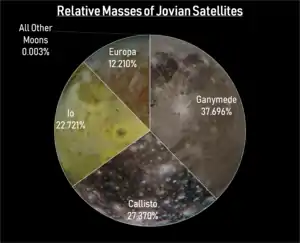
Jupiter's regular satellites are believed to have formed from a circumplanetary disk, a ring of accreting gas and solid debris analogous to a protoplanetary disk.[3][4] They may be the remnants of a score of Galilean-mass satellites that formed early in Jupiter's history.[3][5]
Simulations suggest that, while the disk had a relatively high mass at any given moment, over time a substantial fraction (several tens of a percent) of the mass of Jupiter captured from the solar nebula was passed through it. However, only 2% of the proto-disk mass of Jupiter is required to explain the existing satellites.[3] Thus there may have been several generations of Galilean-mass satellites in Jupiter's early history. Each generation of moons might have spiraled into Jupiter, because of drag from the disk, with new moons then forming from the new debris captured from the solar nebula.[3] By the time the present (possibly fifth) generation formed, the disk had thinned so that it no longer greatly interfered with the moons' orbits.[5] The current Galilean moons were still affected, falling into and being partially protected by an orbital resonance with each other, which still exists for Io, Europa, and Ganymede. Ganymede's larger mass means that it would have migrated inward at a faster rate than Europa or Io.[3]
The outer, irregular moons are thought to have originated from captured asteroids, whereas the protolunar disk was still massive enough to absorb much of their momentum and thus capture them into orbit. Many are believed to have broken up by mechanical stresses during capture, or afterward by collisions with other small bodies, producing the moons we see today.[6]
Discovery
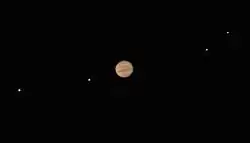

Chinese historian Xi Zezong claimed that the earliest record of a Jovian moon (Ganymede or Callisto) was a note by Chinese astronomer Gan De of an observation around 364 BC regarding a "reddish star".[7] However, the first certain observations of Jupiter's satellites were those of Galileo Galilei in 1609.[8] By January 1610, he had sighted the four massive Galilean moons with his 20× magnification telescope, and he published his results in March 1610.[9]
Simon Marius had independently discovered the moons one day after Galileo, although he did not publish his book on the subject until 1614. Even so, the names Marius assigned are used today: Ganymede; Callisto; Io; and Europa.[10] No additional satellites were discovered until E. E. Barnard observed Amalthea in 1892.[11]
With the aid of telescopic photography, further discoveries followed quickly over the course of the 20th century. Himalia was discovered in 1904,[12] Elara in 1905,[13] Pasiphae in 1908,[14] Sinope in 1914,[15] Lysithea and Carme in 1938,[16] Ananke in 1951,[17] and Leda in 1974.[18] By the time that the Voyager space probes reached Jupiter, around 1979, 13 moons had been discovered, not including Themisto, which had been observed in 1975,[19] but was lost until 2000 due to insufficient initial observation data. The Voyager spacecraft discovered an additional three inner moons in 1979: Metis; Adrastea; and Thebe.[20]
No additional moons were discovered for two decades, but between October 1999 and February 2003, researchers found another 34 moons using sensitive ground-based detectors.[21] These are tiny moons, in long, eccentric, generally retrograde orbits, and averaging 3 km (1.9 mi) in diameter, with the largest being just 9 km (5.6 mi) across. All of these moons are thought to have been captured asteroidal or perhaps comet bodies, possibly fragmented into several pieces.[22][23]
By 2015, a total of 15 additional moons were discovered.[23] Two more were discovered in 2016 by the team led by Scott S. Sheppard at the Carnegie Institution for Science, bringing the total to 69.[24] On 17 July 2018, the International Astronomical Union confirmed that Sheppard's team had discovered ten more moons around Jupiter, bringing the total number to 79.[2] Among these is Valetudo, which has a prograde orbit, but crosses paths with several moons that have retrograde orbits, making an eventual collision—at some point on a billions-of-years timescale—likely.[2]
In September 2020, researchers from the University of British Columbia identified 45 candidate moons from an analysis of archival images taken in 2010 by the Canada-France-Hawaii Telescope.[25] These candidates were mainly small and faint, down to a magnitude of 25.7 or over 800 m (0.50 mi) in diameter. From the number of candidate moons detected within a sky area of one square degree, the team extrapolated that the population of retrograde Jovian moons brighter than magnitude 25.7 is around 600, within a factor of 2.[26] Although the team considers their characterised candidates to be likely moons of Jupiter, they all remain unconfirmed due to their insufficient observation data for determining reliable orbits for each of them.[25]
Naming
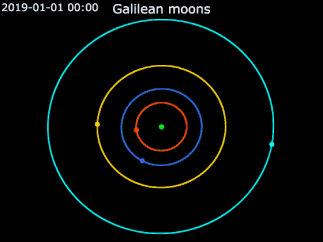
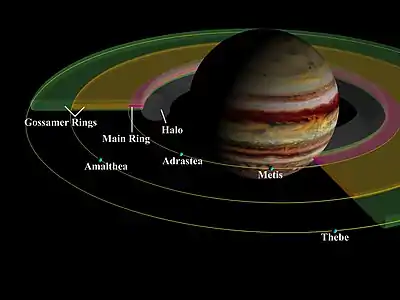
The Galilean moons of Jupiter (Io, Europa, Ganymede, and Callisto) were named by Simon Marius soon after their discovery in 1610.[27] However, these names fell out of favor until the 20th century. The astronomical literature instead simply referred to "Jupiter I", "Jupiter II", etc., or "the first satellite of Jupiter", "Jupiter's second satellite", and so on.[27] The names Io, Europa, Ganymede, and Callisto became popular in the mid-20th century,[28] whereas the rest of the moons remained unnamed and were usually numbered in Roman numerals V (5) to XII (12).[29][30] Jupiter V was discovered in 1892 and given the name Amalthea by a popular though unofficial convention, a name first used by French astronomer Camille Flammarion.[21][31]
The other moons were simply labeled by their Roman numeral (e.g. Jupiter IX) in the majority of astronomical literature until the 1970s.[32] In 1975, the International Astronomical Union's (IAU) Task Group for Outer Solar System Nomenclature granted names to satellites V–XIII,[33] and provided for a formal naming process for future satellites still to be discovered.[33] The practice was to name newly discovered moons of Jupiter after lovers and favorites of the god Jupiter (Zeus) and, since 2004, also after their descendants.[21] All of Jupiter's satellites from XXXIV (Euporie) onward are named after descendants of Jupiter or Zeus,[21] except LIII (Dia), named after a lover of Jupiter. Names ending with "a" or "o" are used for prograde irregular satellites (the latter for highly inclined satellites), and names ending with "e" are used for retrograde irregulars.[34] With the discovery of smaller, kilometre-sized moons around Jupiter, the IAU has established an additional convention to limit the naming of small moons with absolute magnitudes greater than 18 or diameters smaller than 1 km (0.62 mi).[35] Some of the most recently confirmed moons have not received names.
Some asteroids share the same names as moons of Jupiter: 9 Metis, 38 Leda, 52 Europa, 85 Io, 113 Amalthea, 239 Adrastea. Two more asteroids previously shared the names of Jovian moons until spelling differences were made permanent by the IAU: Ganymede and asteroid 1036 Ganymed; and Callisto and asteroid 204 Kallisto.
Groups
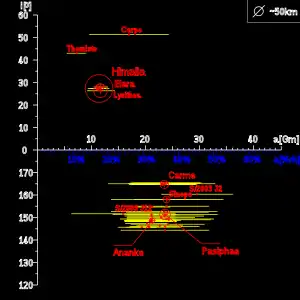
Regular satellites
These have prograde and nearly circular orbits of low inclination and are split into two groups:
- Inner satellites or Amalthea group: Metis, Adrastea, Amalthea, and Thebe. These orbit very close to Jupiter; the innermost two orbit in less than a Jovian day. The latter two are respectively the fifth and seventh largest moons in the Jovian system. Observations suggest that at least the largest member, Amalthea, did not form on its present orbit, but farther from the planet, or that it is a captured Solar System body.[36] These moons, along with a number of seen and as-yet-unseen inner moonlets (see Amalthea moonlets), replenish and maintain Jupiter's faint ring system. Metis and Adrastea help to maintain Jupiter's main ring, whereas Amalthea and Thebe each maintain their own faint outer rings.[37][38]
- Main group or Galilean moons: Io, Europa, Ganymede and Callisto. They are some of the largest objects in the Solar System outside the Sun and the eight planets in terms of mass and are larger than any known dwarf planet. Ganymede exceeds even the planet Mercury in diameter, though is less massive. They are respectively the fourth-, sixth-, first-, and third-largest natural satellites in the Solar System, containing approximately 99.997% of the total mass in orbit around Jupiter, while Jupiter is almost 5,000 times more massive than the Galilean moons.[note 2] The inner moons are in a 1:2:4 orbital resonance. Models suggest that they formed by slow accretion in the low-density Jovian subnebula—a disc of the gas and dust that existed around Jupiter after its formation—which lasted up to 10 million years in the case of Callisto.[39] Several are suspected of having subsurface oceans.
Irregular satellites

The irregular satellites are substantially smaller objects with more distant and eccentric orbits. They form families with shared similarities in orbit (semi-major axis, inclination, eccentricity) and composition; it is believed that these are at least partially collisional families that were created when larger (but still small) parent bodies were shattered by impacts from asteroids captured by Jupiter's gravitational field. These families bear the names of their largest members. The identification of satellite families is tentative, but the following are typically listed:[1][40][41]
- Prograde satellites:
- Themisto is the innermost irregular moon and is not part of a known family.[1][40]
- The Himalia group is spread over barely 1.4 Gm in semi-major axes, 1.6° in inclination (27.5 ± 0.8°), and eccentricities between 0.11 and 0.25. It has been suggested that the group could be a remnant of the break-up of an asteroid from the asteroid belt.[40]
- Carpo is another prograde moon and is not part of a known family. It has the highest inclination of all of the prograde moons.[1]
- Valetudo is the outermost prograde moon and is not part of a known family. Its prograde orbit crosses paths with several moons that have retrograde orbits and may in the future collide with them.[2]
- Retrograde satellites:
 Retrograde satellites: inclinations (°) vs. eccentricities, with Carme's (orange) and Ananke's (yellow) groups identified. Data as of 2009.
Retrograde satellites: inclinations (°) vs. eccentricities, with Carme's (orange) and Ananke's (yellow) groups identified. Data as of 2009.- The Carme group is spread over only 1.2 Gm in semi-major axis, 1.6° in inclination (165.7 ± 0.8°), and eccentricities between 0.23 and 0.27. It is very homogeneous in color (light red) and is believed to have originated from a D-type asteroid progenitor, possibly a Jupiter trojan.[22]
- The Ananke group has a relatively wider spread than the previous groups, over 2.4 Gm in semi-major axis, 8.1° in inclination (between 145.7° and 154.8°), and eccentricities between 0.02 and 0.28. Most of the members appear gray, and are believed to have formed from the breakup of a captured asteroid.[22]
- The Pasiphae group is quite dispersed, with a spread over 1.3 Gm, inclinations between 144.5° and 158.3°, and eccentricities between 0.25 and 0.43.[22] The colors also vary significantly, from red to grey, which might be the result of multiple collisions. Sinope, sometimes included in the Pasiphae group,[22] is red and, given the difference in inclination, it could have been captured independently;[40] Pasiphae and Sinope are also trapped in secular resonances with Jupiter.[42]
List
The moons of Jupiter are listed below by orbital period. Moons massive enough for their surfaces to have collapsed into a spheroid are highlighted in bold. These are the four Galilean moons, which are comparable in size to the Moon. The other moons are much smaller, with the least massive Galilean moon being more than 7000 times more massive than the most massive of the other moons. The irregular captured moons are shaded light gray when prograde and dark gray when retrograde. The orbits and mean distances of the irregular moons are strongly variable over short timescales due to frequent planetary and solar perturbations,[43] therefore the orbit epochs of all irregular moons are based on the same Julian date of 2459200.5, or 17 December 2020.[44] As of 2021, S/2003 J 10 is the only moon of Jupiter considered lost due to its uncertain orbit.[45] A number of other moons have only been observed for a year or two, but have decent enough orbits to be easily measurable at present.[43]
| Key | ||||
|---|---|---|---|---|
| ♠ Galilean moons |
† Prograde irregular moons |
‡ Retrograde moons | ||
| Order [note 3] |
Label [note 4] |
Name |
Pronunciation | Image | Abs. magn. |
Diameter (km)[note 5] | Mass (×1016 kg) |
Semi-major axis (km)[46] |
Orbital period (d) [46][note 6] |
Inclination (°)[46] |
Eccentricity [1] |
Discovery year[21] |
Discoverer[21] | Group [note 7] |
|---|---|---|---|---|---|---|---|---|---|---|---|---|---|---|
| 1 | XVI | Metis | /ˈmiːtɪs/ | 10.5 | 43 (60 × 40 × 34) | ≈ 3.6 | 128852 | +0.2988 (+7h 10m 16s) | 2.226 | 0.0077 | 1979 | Synnott (Voyager 1) | Inner | |
| 2 | XV | Adrastea | /ædrəˈstiːə/ | 12.0 | 16.4 (20 × 16 × 14) | ≈ 0.2 | 129000 | +0.3023 (+7h 15m 21s) | 2.217 | 0.0063 | 1979 | Jewitt (Voyager 2) | Inner | |
| 3 | V | Amalthea | /æməlˈθiːə/[47] | 7.1 | 167 (250 × 146 × 128) | 208 | 181366 | +0.5012 (+12h 01m 46s) | 2.565 | 0.0075 | 1892 | Barnard | Inner | |
| 4 | XIV | Thebe | /ˈθiːbiː/ | 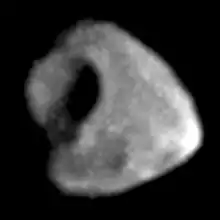 | 9.0 | 98.6 (116 × 98 × 84) | ≈ 43 | 222452 | +0.6778 (+16h 16m 02s) | 2.909 | 0.0180 | 1979 | Synnott (Voyager 1) | Inner |
| 5 | I | Io♠ | /ˈaɪoʊ/ | 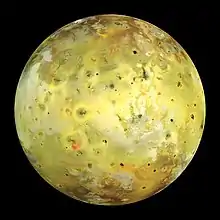 | −1.7 | 3643.2 (3660 × 3637 × 3631) | 8931900 | 421700 | +1.7691 | 0.050[48] | 0.0041 | 1610 | Galilei | Galilean |
| 6 | II | Europa♠ | /jʊəˈroʊpə/[49] | 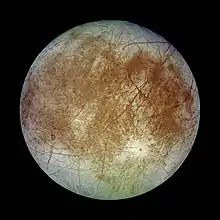 | −1.4 | 3121.6 | 4800000 | 671034 | +3.5512 | 0.471[48] | 0.0094 | 1610 | Galilei | Galilean |
| 7 | III | Ganymede♠ | /ˈɡænɪmiːd/[50][51] |  | −2.1 | 5262.4 | 14819000 | 1070412 | +7.1546 | 0.204[48] | 0.0011 | 1610 | Galilei | Galilean |
| 8 | IV | Callisto♠ | /kəˈlɪstoʊ/ | 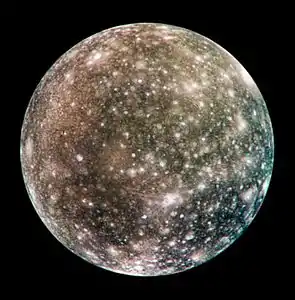 | −1.2 | 4820.6 | 10759000 | 1882709 | +16.689 | 0.205[48] | 0.0074 | 1610 | Galilei | Galilean |
| 9 | XVIII | Themisto† | /θɪˈmɪstoʊ/ |  | 12.9 | 9 | ≈ 0.069 | 7405000 | +130.18 | 44.590 | 0.2514 | 1975/2000 | Kowal & Roemer/ Sheppard et al. | Themisto |
| 10 | XIII | Leda† | /ˈliːdə/ | 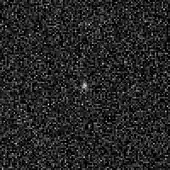 | 12.7 | 21.5 | ≈ 0.6 | 11196000 | +242.02 | 27.641 | 0.1648 | 1974 | Kowal | Himalia |
| 11 | LXXI | Ersa† | /ˈɜːrsə/ | 15.9 | 3 | ≈ 0.0045 | 11348700 | +246.99 | 31.028 | 0.1043 | 2018 | Sheppard et al. | Himalia | |
| 12 | LXV | Pandia† | /pænˈdaɪə/ | 16.2 | 3 | ≈ 0.0045 | 11462300 | +250.71 | 27.023 | 0.2084 | 2017 | Sheppard et al. | Himalia | |
| 13 | VI | Himalia† | /hɪˈmeɪliə/ | 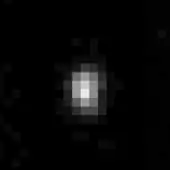 | 7.9 | 139.6 (150 × 120) | 420 | 11497400 | +251.86 | 30.214 | 0.1510 | 1904 | Perrine | Himalia |
| 14 | X | Lysithea† | /laɪˈsɪθiə/ |  | 11.2 | 42.2 | ≈ 6.3 | 11628300 | +256.17 | 27.015 | 0.1377 | 1938 | Nicholson | Himalia |
| 15 | VII | Elara† | /ˈɛlərə/ |  | 9.6 | 79.9 | ≈ 87 | 11671600 | +257.60 | 30.216 | 0.2079 | 1905 | Perrine | Himalia |
| 16 | LIII | Dia† | /ˈdaɪə/ | 16.3 | 4 | ≈ 0.009 | 12304900 | +278.85 | 27.481 | 0.2606 | 2000 | Sheppard et al. | Himalia | |
| 17 | XLVI | Carpo† | /ˈkɑːrpoʊ/ | 16.1 | 3 | ≈ 0.0045 | 17151800 | +458.90 | 50.138 | 0.4967 | 2003 | Sheppard et al. | Carpo | |
| 18 | LXII | Valetudo† | /vælɪˈtjuːdoʊ/ | 16.9 | 1 | ≈ 0.00015 | 18818600 | +527.40 | 32.035 | 0.2019 | 2016 | Sheppard et al. | Valetudo | |
| 19 | XXXIV | Euporie‡ | /ˈjuːpəriː/ | 16.3 | 2 | ≈ 0.0015 | 19593900 | −560.32 | 147.851 | 0.1402 | 2001 | Sheppard et al. | Ananke | |
| 20 | LX | Eupheme‡ | /juːˈfiːmiː/ | 16.6 | 2 | ≈ 0.0015 | 20126300 | −583.31 | 150.042 | 0.4104 | 2003 | Sheppard et al. | Ananke | |
| 21 | LV | S/2003 J 18‡ | 16.5 | 2 | ≈ 0.0015 | 20348800 | −593.01 | 142.783 | 0.0465 | 2003 | Gladman et al. | Ananke | ||
| 22 | LII | S/2010 J 2‡ | 17.3 | 1 | ≈ 0.00015 | 20436700 | −596.86 | 148.697 | 0.3403 | 2010 | Veillet | Ananke | ||
| 23 | XLV | Helike‡ | /ˈhɛlɪkiː/ | 16.0 | 4 | ≈ 0.009 | 20479500 | −598.74 | 155.067 | 0.1331 | 2003 | Sheppard et al. | Ananke | |
| 24 | S/2003 J 16‡ | 16.3 | 2 | ≈ 0.0015 | 20512500 | −600.18 | 151.163 | 0.3331 | 2003 | Gladman et al. | Ananke | |||
| 25 | S/2003 J 2‡ | 16.7 | 2 | ≈ 0.0015 | 20554400 | −602.02 | 149.204 | 0.2777 | 2003 | Sheppard et al. | Ananke | |||
| 26 | XXXIII | Euanthe‡ | /juːˈænθiː/ | 16.4 | 3 | ≈ 0.0045 | 20583300 | −603.29 | 146.808 | 0.1096 | 2001 | Sheppard et al. | Ananke | |
| 27 | LXVIII | S/2017 J 7‡ | 16.6 | 2 | ≈ 0.0015 | 20600100 | −604.03 | 146.739 | 0.2626 | 2017 | Sheppard et al. | Ananke | ||
| 28 | XXX | Hermippe‡ | /hərˈmɪpiː/ | 15.6 | 4 | ≈ 0.009 | 20666200 | −606.94 | 146.753 | 0.1981 | 2001 | Sheppard et al. | Ananke | |
| 29 | XXVII | Praxidike‡ | /prækˈsɪdɪkiː/ | 14.9 | 7 | ≈ 0.043 | 20682900 | −607.68 | 149.692 | 0.2959 | 2000 | Sheppard et al. | Ananke | |
| 30 | XXIX | Thyone‡ | /θaɪˈoʊniː/ | 15.8 | 4 | ≈ 0.009 | 20712800 | −609.00 | 147.328 | 0.1770 | 2001 | Sheppard et al. | Ananke | |
| 31 | XLII | Thelxinoe‡ | /θɛlkˈsɪnoʊiː/ | 16.3 | 2 | ≈ 0.0015 | 20893300 | −616.97 | 146.916 | 0.1709 | 2003 | Sheppard et al. | Ananke | |
| 32 | LXIV | S/2017 J 3‡ | 16.5 | 2 | ≈ 0.0015 | 20976900 | −620.68 | 147.968 | 0.1907 | 2017 | Sheppard et al. | Ananke | ||
| 33 | XII | Ananke‡ | /əˈnæŋkiː/ |  | 11.7 | 29.1 | ≈ 3.0 | 21042500 | −623.59 | 148.675 | 0.1747 | 1951 | Nicholson | Ananke |
| 34 | XL | Mneme‡ | /ˈniːmiː/ | 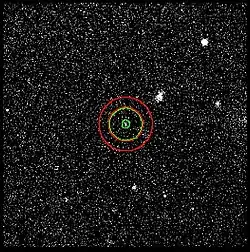 | 16.3 | 2 | ≈ 0.0015 | 21064100 | −624.55 | 151.087 | 0.3428 | 2003 | Gladman et al. | Ananke |
| 35 | LIV | S/2016 J 1‡ | 16.8 | 1 | ≈ 0.00015 | 21154000 | −628.56 | 143.824 | 0.1294 | 2016 | Sheppard et al. | Ananke | ||
| 36 | XXXV | Orthosie‡ | /ɔːrˈθoʊziː/ | 16.7 | 2 | ≈ 0.0015 | 21171000 | −629.31 | 148.488 | 0.4838 | 2001 | Sheppard et al. | Ananke | |
| 37 | XXII | Harpalyke‡ | /hɑːrˈpælɪkiː/ | 15.9 | 4 | ≈ 0.009 | 21280200 | −634.19 | 148.298 | 0.1602 | 2000 | Sheppard et al. | Ananke | |
| 38 | XXIV | Iocaste‡ | /aɪəˈkæstiː/ | 15.4 | 5 | ≈ 0.019 | 21431800 | −640.98 | 149.424 | 0.3295 | 2000 | Sheppard et al. | Ananke | |
| 39 | LXX | S/2017 J 9‡ | 16.1 | 3 | ≈ 0.0045 | 21492900 | −643.72 | 155.775 | 0.2524 | 2017 | Sheppard et al. | Ananke | ||
| 40 | S/2003 J 12‡ | 17.0 | 1 | ≈ 0.00015 | 21557700 | −646.64 | 154.690 | 0.3657 | 2003 | Sheppard et al. | Ananke | |||
| 41 | S/2003 J 4‡ | 16.7 | 2 | ≈ 0.0015 | 22048600 | −668.85 | 149.401 | 0.4967 | 2003 | Sheppard et al. | Pasiphae | |||
| 42 | XXV | Erinome‡ | /ɛˈrɪnəmiː/ (?) | 16.0 | 3 | ≈ 0.0045 | 22354300 | −682.80 | 164.821 | 0.2052 | 2000 | Sheppard et al. | Carme | |
| 43 | XXXI | Aitne‡ | /ˈeɪtniː/ | 16.0 | 3 | ≈ 0.0045 | 22386500 | −684.28 | 166.238 | 0.3150 | 2001 | Sheppard et al. | Carme | |
| 44 | L | Herse‡ | /ˈhɜːrsiː/ | 16.5 | 2 | ≈ 0.0015 | 22408800 | −685.30 | 164.347 | 0.1854 | 2003 | Gladman et al. | Carme | |
| 45 | XX | Taygete‡ | /teɪˈɪdʒɪtiː/ | 15.5 | 5 | ≈ 0.016 | 22433500 | −686.44 | 163.261 | 0.3257 | 2000 | Sheppard et al. | Carme | |
| 46 | LXIII | S/2017 J 2‡ | 16.4 | 2 | ≈ 0.0015 | 22472900 | −688.25 | 165.676 | 0.3852 | 2017 | Sheppard et al. | Carme | ||
| 47 | LXVII | S/2017 J 6‡ | 16.4 | 2 | ≈ 0.0015 | 22543800 | −691.51 | 155.185 | 0.3226 | 2017 | Sheppard et al. | Pasiphae | ||
| 48 | XLVII | Eukelade‡ | /juːˈkɛlədiː/ | 15.9 | 4 | ≈ 0.009 | 22576700 | −693.02 | 163.822 | 0.2790 | 2003 | Sheppard et al. | Carme | |
| 49 | XI | Carme‡ | /ˈkɑːrmiː/ | 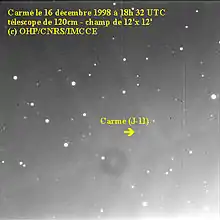 | 10.6 | 46.7 | ≈ 13 | 22579900 | −693.17 | 163.535 | 0.2295 | 1938 | Nicholson | Carme |
| 50 | LXI | S/2003 J 19‡ | 16.6 | 2 | ≈ 0.0015 | 22752500 | −701.13 | 167.738 | 0.2928 | 2003 | Gladman et al. | Carme | ||
| 51 | XXVI | Isonoe‡ | /aɪˈsɒnoʊiː/ | 16.0 | 4 | ≈ 0.009 | 22776700 | −702.25 | 162.834 | 0.2159 | 2000 | Sheppard et al. | Carme | |
| 52 | XXVIII | Autonoe‡ | /ɔːˈtɒnoʊiː/ | 15.5 | 4 | ≈ 0.009 | 22933400 | −709.51 | 148.145 | 0.4290 | 2001 | Sheppard et al. | Pasiphae | |
| 53 | LVIII | Philophrosyne‡ | /fɪləˈfrɒzɪniː/ | 16.7 | 2 | ≈ 0.0015 | 22939900 | −709.81 | 147.900 | 0.3013 | 2003 | Sheppard et al. | Pasiphae | |
| 54 | XLVIII | Cyllene‡ | /sɪˈliːniː/ | 16.3 | 2 | ≈ 0.0015 | 22965200 | −710.99 | 150.047 | 0.6079 | 2003 | Sheppard et al. | Pasiphae | |
| 55 | XXXVIII | Pasithee‡ | /ˈpæsɪθiː/ | 16.8 | 2 | ≈ 0.0015 | 22967800 | −711.11 | 164.727 | 0.2097 | 2001 | Sheppard et al. | Carme | |
| 56 | LI | S/2010 J 1‡ | 16.4 | 2 | ≈ 0.0015 | 22986900 | −712.00 | 164.559 | 0.2937 | 2010 | Jacobson et al. | Carme | ||
| 57 | (lost) | S/2003 J 10‡ | 16.7 | 2 | ≈ 0.0015 | 23008000 | −713.05 | 163.539 | 0.2133 | 2003 | Sheppard et al. | Carme? | ||
| 58 | VIII | Pasiphae‡ | /pəˈsɪfeɪiː/ | 10.1 | 57.8 | ≈ 30 | 23119300 | −718.16 | 151.998 | 0.4362 | 1908 | Melotte | Pasiphae | |
| 59 | XXXVI | Sponde‡ | /ˈspɒndiː/ | 16.7 | 2 | ≈ 0.0015 | 23146500 | −719.42 | 144.563 | 0.3455 | 2001 | Sheppard et al. | Pasiphae | |
| 60 | LXIX | S/2017 J 8‡ | 17.0 | 1 | ≈ 0.00015 | 23173700 | −720.69 | 166.071 | 0.2039 | 2017 | Sheppard et al. | Carme | ||
| 61 | XXXII | Eurydome‡ | /jʊəˈrɪdəmiː/ | 16.2 | 3 | ≈ 0.0045 | 23214500 | −722.59 | 150.289 | 0.2975 | 2001 | Sheppard et al. | Pasiphae | |
| 62 | LXVI | S/2017 J 5‡ | 16.5 | 2 | ≈ 0.0015 | 23352500 | −729.05 | 166.555 | 0.2460 | 2017 | Sheppard et al. | Carme | ||
| 63 | XXIII | Kalyke‡ | /ˈkælɪkiː/ | 15.4 | 6.9 | ≈ 0.04 | 23377400 | −730.21 | 166.899 | 0.2660 | 2000 | Sheppard et al. | Carme | |
| 64 | XXXIX | Hegemone‡ | /hɪˈdʒɛməniː/ | 15.9 | 3 | ≈ 0.0045 | 23422300 | −732.32 | 154.675 | 0.3358 | 2003 | Sheppard et al. | Pasiphae | |
| 65 | XXXVII | Kale‡ | /ˈkeɪliː/ | 16.4 | 2 | ≈ 0.0015 | 23512200 | −736.54 | 166.177 | 0.2893 | 2001 | Sheppard et al. | Carme | |
| 66 | XLIV | Kallichore‡ | /kəˈlɪkəriː/ | 16.4 | 2 | ≈ 0.0015 | 23552900 | −738.45 | 167.727 | 0.3183 | 2003 | Sheppard et al. | Carme | |
| 67 | LXXII | S/2011 J 1‡ | 16.7 | 2 | ≈ 0.0015 | 23714400 | −746.06 | 164.799 | 0.3193 | 2011 | Sheppard et al. | Carme | ||
| 68 | LIX | S/2017 J 1‡ | 16.6 | 2 | ≈ 0.0015 | 23753600 | −747.91 | 147.253 | 0.4500 | 2017 | Sheppard et al. | Pasiphae | ||
| 69 | XXI | Chaldene‡ | /kælˈdiːniː/ | 16.0 | 4 | ≈ 0.009 | 23848300 | −752.39 | 162.749 | 0.2705 | 2000 | Sheppard et al. | Carme | |
| 70 | XLIII | Arche‡ | /ˈɑːrkiː/ | 16.2 | 3 | ≈ 0.0045 | 23926500 | −756.09 | 166.408 | 0.2367 | 2002 | Sheppard et al. | Carme | |
| 71 | LVII | Eirene‡ | /aɪˈriːniː/ | 15.8 | 4 | ≈ 0.009 | 23934500 | −756.47 | 162.713 | 0.2413 | 2003 | Sheppard et al. | Carme | |
| 72 | XLIX | Kore‡ | /ˈkɔːriː/ | 16.6 | 2 | ≈ 0.0015 | 23999700 | −759.56 | 136.628 | 0.2347 | 2003 | Sheppard et al. | Pasiphae | |
| 73 | LVI | S/2011 J 2‡ | 16.8 | 1 | ≈ 0.00015 | 24114700 | −765.03 | 152.125 | 0.1729 | 2011 | Sheppard et al. | Pasiphae | ||
| 74 | S/2003 J 9‡ | 16.9 | 1 | ≈ 0.00015 | 24168700 | −767.60 | 166.334 | 0.1702 | 2003 | Sheppard et al. | Carme | |||
| 75 | XIX | Megaclite‡ | /ˌmɛɡəˈklaɪtiː/ | 15.0 | 5 | ≈ 0.021 | 24212300 | −769.68 | 145.574 | 0.3139 | 2000 | Sheppard et al. | Pasiphae | |
| 76 | XLI | Aoede‡ | /eɪˈiːdiː/ | 15.6 | 4 | ≈ 0.009 | 24283000 | −773.05 | 151.908 | 0.3131 | 2003 | Sheppard et al. | Pasiphae | |
| 77 | S/2003 J 23‡ | 16.6 | 2 | ≈ 0.0015 | 24678200 | −792.00 | 146.155 | 0.3208 | 2003 | Sheppard et al. | Pasiphae | |||
| 78 | XVII | Callirrhoe‡ | /kəˈlɪroʊiː/ | 13.9 | 9.6 | ≈ 0.087 | 24692400 | −792.69 | 149.792 | 0.3562 | 1999 | Scotti et al. | Pasiphae | |
| 79 | IX | Sinope‡ | /sɪˈnoʊpiː/ | 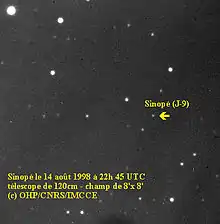 | 11.1 | 35 | ≈ 7.5 | 24864100 | −800.97 | 158.597 | 0.1669 | 1914 | Nicholson | Pasiphae |
Exploration

The first spacecraft to visit Jupiter were Pioneer 10 in 1973, and Pioneer 11 a year later, taking low-resolution images of the four Galilean moons and returning data on their atmospheres and radiation belts.[52] The Voyager 1 and Voyager 2 probes visited Jupiter in 1979, discovering the volcanic activity on Io and the presence of water ice on the surface of Europa. The Cassini probe to Saturn flew by Jupiter in 2000 and collected data on interactions of the Galilean moons with Jupiter's extended atmosphere. The New Horizons spacecraft flew by Jupiter in 2007 and made improved measurements of its satellites' orbital parameters.
The Galileo spacecraft was the first to enter orbit around Jupiter, arriving in 1995 and studying it until 2003. During this period, Galileo gathered a large amount of information about the Jovian system, making close approaches to all of the Galilean moons and finding evidence for thin atmospheres on three of them, as well as the possibility of liquid water beneath the surfaces of Europa, Ganymede, and Callisto. It also discovered a magnetic field around Ganymede.
In 2016, the Juno spacecraft imaged the Galilean moons from above their orbital plane as it approached Jupiter orbit insertion, creating a time-lapse movie of their motion.[53]
Notes
- For comparison, the area of a sphere with diameter 250 km is about the area of Senegal and comparable to the area of Belarus, Syria and Uruguay. The area of a sphere with a diameter of 5 km is about the area of Guernsey and somewhat more than the area of San Marino. (But note that these smaller moons are not spherical.)
- Jupiter Mass of 1.8986 × 1027 kg / Mass of Galilean moons 3.93 × 1023 kg = 4,828
- Order refers to the position among other moons with respect to their average distance from Jupiter.
- Label refers to the Roman numeral attributed to each moon in order of their naming.
- Diameters with multiple entries such as "60 × 40 × 34" reflect that the body is not a perfect spheroid and that each of its dimensions has been measured well enough.
- Periods with negative values are retrograde.
- "?" refers to group assignments that are not considered sure yet.
References
- Scott S. Sheppard. "Jupiter's Known Satellites". Departament of Terrestrial Magnetism at Carniege Institution for science. Retrieved 17 July 2018.
- "A dozen new moons of Jupiter discovered, including one "oddball"". Carnegie Institution for Science. 16 July 2018. Retrieved 17 July 2018.
- Canup, Robert M.; Ward, William R. (2009). "Origin of Europa and the Galilean Satellites". Europa. University of Arizona Press (in press). arXiv:0812.4995. Bibcode:2009euro.book...59C.
- Alibert, Y.; Mousis, O.; Benz, W. (2005). "Modeling the Jovian subnebula I. Thermodynamic conditions and migration of proto-satellites". Astronomy & Astrophysics. 439 (3): 1205–13. arXiv:astro-ph/0505367. Bibcode:2005A&A...439.1205A. doi:10.1051/0004-6361:20052841. S2CID 2260100.
- Chown, Marcus (7 March 2009). "Cannibalistic Jupiter ate its early moons". New Scientist. Retrieved 18 March 2009.
- Jewitt, David; Haghighipour, Nader (2007). "Irregular Satellites of the Planets: Products of Capture in the Early Solar System" (PDF). Annual Review of Astronomy and Astrophysics. 45 (1): 261–95. arXiv:astro-ph/0703059. Bibcode:2007ARA&A..45..261J. doi:10.1146/annurev.astro.44.051905.092459. S2CID 13282788. Archived from the original (PDF) on 19 September 2009.
- Xi, Zezong Z. (February 1981). "The Discovery of Jupiter's Satellite Made by Gan De 2000 years Before Galileo". Acta Astrophysica Sinica. 1 (2): 87. Bibcode:1981AcApS...1...85X.
- Galilei, Galileo (1989). Translated and prefaced by Albert Van Helden (ed.). Sidereus Nuncius. Chicago & London: University of Chicago Press. pp. 14–16. ISBN 0-226-27903-0.
- Van Helden, Albert (March 1974). "The Telescope in the Seventeenth Century". Isis. The University of Chicago Press on behalf of The History of Science Society. 65 (1): 38–58. doi:10.1086/351216.
- Pasachoff, Jay M. (2015). "Simon Marius's Mundus Iovialis: 400th Anniversary in Galileo's Shadow". Journal for the History of Astronomy. 46 (2): 218–234. Bibcode:2015AAS...22521505P. doi:10.1177/0021828615585493. S2CID 120470649.
- Barnard, E. E. (1892). "Discovery and Observation of a Fifth Satellite to Jupiter". Astronomical Journal. 12: 81–85. Bibcode:1892AJ.....12...81B. doi:10.1086/101715.
- Barnard, E. E. (9 January 1905). "Discovery of a Sixth Satellite of Jupiter". Astronomical Journal. 24 (18): 154B. Bibcode:1905AJ.....24S.154.. doi:10.1086/103654.
- Perrine, C. D. (1905). "The Seventh Satellite of Jupiter". Publications of the Astronomical Society of the Pacific. 17 (101): 62–63. Bibcode:1905PASP...17...56.. doi:10.1086/121624. JSTOR 40691209.
- Melotte, P. J. (1908). "Note on the Newly Discovered Eighth Satellite of Jupiter, Photographed at the Royal Observatory, Greenwich". Monthly Notices of the Royal Astronomical Society. 68 (6): 456–457. Bibcode:1908MNRAS..68..456.. doi:10.1093/mnras/68.6.456.
- Nicholson, S. B. (1914). "Discovery of the Ninth Satellite of Jupiter". Publications of the Astronomical Society of the Pacific. 26 (1): 197–198. Bibcode:1914PASP...26..197N. doi:10.1086/122336. PMC 1090718. PMID 16586574.
- Nicholson, S.B. (1938). "Two New Satellites of Jupiter". Publications of the Astronomical Society of the Pacific. 50 (297): 292–293. Bibcode:1938PASP...50..292N. doi:10.1086/124963.
- Nicholson, S. B. (1951). "An unidentified object near Jupiter, probably a new satellite". Publications of the Astronomical Society of the Pacific. 63 (375): 297–299. Bibcode:1951PASP...63..297N. doi:10.1086/126402.
- Kowal, C. T.; Aksnes, K.; Marsden, B. G.; Roemer, E. (1974). "Thirteenth satellite of Jupiter". Astronomical Journal. 80: 460–464. Bibcode:1975AJ.....80..460K. doi:10.1086/111766.
- Marsden, Brian G. (3 October 1975). "Probable New Satellite of Jupiter" (discovery telegram sent to the IAU). IAU Circular. Cambridge, US: Smithsonian Astrophysical Observatory. 2845. Retrieved 8 January 2011.
- Synnott, S.P. (1980). "1979J2: The Discovery of a Previously Unknown Jovian Satellite". Science. 210 (4471): 786–788. Bibcode:1980Sci...210..786S. doi:10.1126/science.210.4471.786. PMID 17739548.
- Gazetteer of Planetary Nomenclature Planet and Satellite Names and Discoverers International Astronomical Union (IAU)
- Sheppard, Scott S.; Jewitt, David C. (5 May 2003). "An abundant population of small irregular satellites around Jupiter". Nature. 423 (6937): 261–263. Bibcode:2003Natur.423..261S. doi:10.1038/nature01584. PMID 12748634. S2CID 4424447.
- Williams, Matt (14 September 2015). "How Many Moons Does Jupiter Have? - Universe Today". Universe Today. Retrieved 18 July 2018.
- Bennett, Jay (13 June 2017). "Jupiter Officially Has Two More Moons". Popular Mechanics. Retrieved 18 July 2018.
- Schilling, Govert (8 September 2020). "Study Suggests Jupiter Could Have 600 Moons". Sky & Telescope. Retrieved 9 September 2020.
- Ashton, Edward; Beaudoin, Matthew; Gladman, Brett (September 2020). "The Population of Kilometer-scale Retrograde Jovian Irregular Moons". The Planetary Science Journal. 1 (2): 52. arXiv:2009.03382. Bibcode:2020arXiv200903382A. doi:10.3847/PSJ/abad95. S2CID 221534456.
- Marazzini, C. (2005). "The names of the satellites of Jupiter: from Galileo to Simon Marius". Lettere Italiane (in Italian). 57 (3): 391–407.
- Marazzini, Claudio (2005). "I nomi dei satelliti di Giove: da Galileo a Simon Marius (The names of the satellites of Jupiter: from Galileo to Simon Marius)". Lettere Italiane. 57 (3): 391–407.
- Nicholson, Seth Barnes (April 1939). "The Satellites of Jupiter". Publications of the Astronomical Society of the Pacific. 51 (300): 85–94. Bibcode:1939PASP...51...85N. doi:10.1086/125010.
- Owen, Tobias (September 1976). "Jovian Satellite Nomenclature". Icarus. 29 (1): 159–163. Bibcode:1976Icar...29..159O. doi:10.1016/0019-1035(76)90113-5.
- Sagan, Carl (April 1976). "On Solar System Nomenclature". Icarus. 27 (4): 575–576. Bibcode:1976Icar...27..575S. doi:10.1016/0019-1035(76)90175-5.
- Payne-Gaposchkin, Cecilia; Haramundanis, Katherine (1970). Introduction to Astronomy. Englewood Cliffs, N.J.: Prentice-Hall. ISBN 0-13-478107-4.
- Marsden, Brian G. (3 October 1975). "Satellites of Jupiter". IAU Circular. 2846. Retrieved 8 January 2011.
- Antonietta Barucci, M. (2008). "Irregular Satellites of the Giant Planets" (PDF). In M. Antonietta Barucci; Hermann Boehnhardt; Dale P. Cruikshank; Alessandro Morbidelli (eds.). The Solar System Beyond Neptune. p. 414. ISBN 9780816527557. Archived from the original (PDF) on 10 August 2017. Retrieved 22 July 2017.
- "IAU Rules and Conventions". Working Group for Planetary System Nomenclature. U.S. Geological Survey. Retrieved 10 September 2020.
- Anderson, J.D.; Johnson, T.V.; Shubert, G.; et al. (2005). "Amalthea's Density Is Less Than That of Water". Science. 308 (5726): 1291–1293. Bibcode:2005Sci...308.1291A. doi:10.1126/science.1110422. PMID 15919987. S2CID 924257.
- Burns, J.A.; Simonelli, D. P.; Showalter, M.R.; et al. (2004). "Jupiter's Ring-Moon System". In Bagenal, F.; Dowling, T.E.; McKinnon, W.B. (eds.). Jupiter: The Planet, Satellites and Magnetosphere. Cambridge University Press.
- Burns, J. A.; Showalter, M. R.; Hamilton, D. P.; et al. (1999). "The Formation of Jupiter's Faint Rings". Science. 284 (5417): 1146–1150. Bibcode:1999Sci...284.1146B. doi:10.1126/science.284.5417.1146. PMID 10325220. S2CID 21272762.
- Canup, Robin M.; Ward, William R. (2002). "Formation of the Galilean Satellites: Conditions of Accretion" (PDF). The Astronomical Journal. 124 (6): 3404–3423. Bibcode:2002AJ....124.3404C. doi:10.1086/344684.
- Grav, T.; Holman, M.; Gladman, B.; Aksnes K. (2003). "Photometric survey of the irregular satellites". Icarus. 166 (1): 33–45. arXiv:astro-ph/0301016. Bibcode:2003Icar..166...33G. doi:10.1016/j.icarus.2003.07.005. S2CID 7793999.CS1 maint: multiple names: authors list (link)
- Sheppard, Scott S.; Jewitt, David C.; Porco, Carolyn (2004). "Jupiter's outer satellites and Trojans" (PDF). In Fran Bagenal; Timothy E. Dowling; William B. McKinnon (eds.). Jupiter. The planet, satellites and magnetosphere. Cambridge planetary science. 1. Cambridge, UK: Cambridge University Press. pp. 263–280. ISBN 0-521-81808-7. Archived from the original (PDF) on 26 March 2009.
- Nesvorný, David; Beaugé, Cristian; Dones, Luke (2004). "Collisional Origin of Families of Irregular Satellites" (PDF). The Astronomical Journal. 127 (3): 1768–1783. Bibcode:2004AJ....127.1768N. doi:10.1086/382099.
- Brozović, Marina; Jacobson, Robert A. (March 2017). "The Orbits of Jupiter's Irregular Satellites". The Astronomical Journal. 153 (4): 147. Bibcode:2017AJ....153..147B. doi:10.3847/1538-3881/aa5e4d.
- "HORIZONS Web-Interface". Horizons output. Jet Propulsion Laboratory. Retrieved 1 January 2021. ("Ephemeris Type" select "Orbital Elements" · Set "Time Span" to 2020-Dec-17)
- Hecht, Jeff (11 January 2021). "Amateur Astronomer Finds "Lost" Moons of Jupiter". skyandtelescope.org. Sky & Telescope. Retrieved 11 January 2021.
- "Natural Satellites Ephemeris Service". IAU: Minor Planet Center. Retrieved 8 January 2011.
Note: some semi-major axis were computed using the µ value, while the eccentricities were taken using the inclination to the local Laplace plane
- "Amalthea". Merriam-Webster Dictionary.
- Siedelmann P.K.; Abalakin V.K.; Bursa, M.; Davies, M.E.; et al. (2000). The Planets and Satellites 2000 (Report). IAU/IAG Working Group on Cartographic Coordinates and Rotational Elements of the Planets and Satellites. Retrieved 31 August 2008.
- "Europa - definition of Europa in English from the Oxford dictionary". OxfordDictionaries.com. Retrieved 20 January 2016.
- "Ganymede - definition of Ganymede in English from the Oxford dictionary". OxfordDictionaries.com. Retrieved 20 January 2016.
- "Ganymede". Merriam-Webster Dictionary.
- Fillius, Walker; McIlwain, Carl; Mogro‐Campero, Antonio; Steinberg, Gerald (1976). "Evidence that pitch angle scattering is an important loss mechanism for energetic electrons in the inner radiation belt of Jupiter". Geophysical Research Letters. 3 (1): 33–36. Bibcode:1976GeoRL...3...33F. doi:10.1029/GL003i001p00033. ISSN 1944-8007.
- Juno Approach Movie of Jupiter and the Galilean Moons, NASA, July 2016
External links
| Wikimedia Commons has media related to Moons of Jupiter. |
.tif.jpg.webp)
